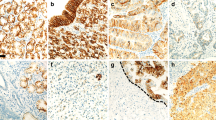Abstract
Connexin 43(Cx43) and E-cadherin are concurrently expressed in many tumors and were ever classified as tumor suppressors in primary tumors (PT), whereas recent studies showed that these two proteins played specific roles in tumor metastasis. The aim of our study is to determine the expression of Cx43 and E-cadherin in primary gastric tumors (PTs) and matched metastatic lymph nodes (MLNs) and to explore the clinical and pathological implications of expression of these proteins. Immunohistochemical assay was conducted to detect the expression of Cx43 and E-cadherin in PTs and MLNs, and the clinical and pathological implications were analyzed by statistical methods. In PTs, the expression of Cx43 and E-cadherin was significantly reduced, compared to adjacent normal tissues (P < 0.01). The expression of Cx43 and E-cadherin was significantly increased in MLNs compared with PTs (P < 0.01 and P < 0.01, for Cx43 and E-cadherin, respectively), and some Cx43 and E-cadherin-negative PTs developed Cx43 and E-cadherin-positive MLNs. Furthermore, reduced expression of both Cx43 and E-cadherin significantly correlated with poor differentiation, advanced TNM stage, and lymph note metastasis of gastric cancers. Cx43 and E-cadherin expression significantly correlated with each other. We concluded that concurrent reduction in Cx43 and E-cadherin may contribute to the occurrence of gastric cancer. However, concurrent increased expression of Cx43 and E-cadherin may contribute to the efficient metastasis of gastric cancer to the lymph nodes.


Similar content being viewed by others
References
Malassiné A, Cronier L. Involvement of gap junctions in placental functions and development. Biochim Biophys Acta. 2005;1719(1–2):117–24.
Willecke K, Eiberger J, Degen J, et al. Structural and functional diversity of connexin genes in the mouse and human genome. Biol Chem. 2002;383(5):725–37.
Pahujaa M, Anikin M, Goldberg GS, et al. Phosphorylation of connexin43 induced by Src: regulation of gap junctional communication between transformed cells. Exp Cell Res. 2007;313(20):4083–90.
El-Sabban ME, Pauli BU. Cytoplasmic dye transfer between metastatic tumor cells and vascular endothelium. J Cell Biol. 1991;115(5):1375–82.
El-Sabban ME, Pauli BU. Adhesion-mediated gap junctional communication between lung-metastatic cancer cells and endothelium. Invasion Metastasis. 1994–1995; 14(1–6):164–76.
Ito A, Katoh F, Kataoka TR, et al. A role for heterologous gap junctions between melanoma and endothelial cells in metastasis. J Clin Invest. 2000;105(9):1189–97.
Prochnow N, Dermietzel R. Connexons and cell adhesion: a romantic phase. Histochem Cell Biol. 2008;130(1):71–7.
Schmalhofer O, Brabletz S, Brabletz T. E-cadherin, beta-catenin, and ZEB1 in malignant progression of cancer. Cancer Metastasis Rev. 2009;28(1–2):151–66.
Tsanou E, Peschos D, Batistatou A, Charalabopoulos A, Charalabopoulos K. The E-cadherin adhesion molecule and colorectal cancer. A global literature approach. Anticancer Res. 2008;28(6A):3815–26.
Nair KS, Naidoo R, Chetty R. Expression of cell adhesion molecules in esophageal carcinoma and its prognostic value. J Clin Pathol. 2005;58(4):343–51.
Natalwala A, Spychal R, Tselepis C. Epithelial-mesenchymal transition mediated tumourigenesis in the gastrointestinal tract. World J Gastroenterol. 2008;14(24):3792–7.
Xu HT, Li QC, Zhang YX, Zhao Y, Liu Y, Yang ZQ, et al. Connexin 43 recruits E-cadherin expression and inhibits the malignant behaviour of lung cancer cells. Folia Histochem Cytobiol. 2008;46(3):315–21.
Li Z, Zhou Z, Donahue HJ. Alterations in Cx43 and OB-cadherin affect breast cancer cell metastatic potential. Clin Exp Metastasis. 2008;25(3):265–72.
Krutovskikh V, Mazzoleni G, Mironov N, Omori Y, Aguelon AM, Mesnil M, et al. Expression of connexins 26, 32 and 43 in the human colon–an immunohistochemical study. Folia Histochem Cytobiol. 2004;42(4):203–7.
Krutovskikh V, Mazzoleni G, Mironov N, Omori Y, Aguelon AM, Mesnil M, et al. Altered homologous and heterologous gap-junctional intercellular communication in primary human liver tumors associated with aberrant protein localization but not gene mutation of connexin 32. Int J Cancer. 1994;56(1):87–94.
Krutovskikh VA, Troyanovsky SM, Piccoli C, Tsuda H, Asamoto M, Yamasaki H. Differential effect of subcellular localization of communication impairing gap junction protein connexin43 on tumor cell growth in vivo. Oncogene. 2000;19(4):505–13.
Rubin H. Contact interactions between cells that suppress neoplastic development: can they also explain metastatic dormancy? Adv Cancer Res. 2008;100(2):159–202.
Kanczuga-Koda L, Sulkowski S, Lenczewski A, et al. Increased expression of connexins 26 and 43 in lymph node metastases of breast cancer. J Clin Pathol. 2006;59(4):429–33.
Pollmann MA, Shao Q, Laird DW, et al. Connexin 43 mediated gap junctional communication enhances breast tumor cell diapedesis in culture. Breast Cancer Res. 2005;7:R522–34.
Ito A, Morita N, Miura D, Koma Y, Kataoka TR, Yamasaki H, et al. A derivative of oleamide potently inhibits the spontaneous metastasis of mouse melanoma BL6 cells. Carcinogenesis. 2004;25(10):2015–22.
Kamibayashi Y, Oyamada Y, Mori M, Oyamada M. Aberrant expression of gap junction proteins (connexins) is associated with tumor progression during multistage mouse skin carcinogenesis in vivo. Carcinogenesis. 1995;16(6):1287–97.
Elias LA, Wang DD, Kriegstein AR. Gap junction adhesion is necessary for radial migration in the neocortex. Nature. 2007;448(7156):901–7.
Xu X, Francis R, Wei CJ, et al. Connexin 43-mediated modulation of polarized cell movement and the directional migration of cardiac neural crest cells. Development. 2006;133(18):3629–39.
Pelin K, Hirvonen A, Linnainmaa K. Expression of cell adhesion molecules and connexins in gap junctional intercellular communication deficient human mesothelioma tumour cell lines and communication competent primary mesothelial cells. Carcinogenesis. 1994;15(11):2673–5.
Kawasaki Y, Kubomoto A, Yamasaki H. Control of intracellular localization and function of Cx43 by SEMA3F. J Membr Biol. 2007;217(1–3):53–61.
Karabekian Z, Gillum ND, Wong EW, Sarvazyan N. Effects of N-cadherin overexpression on the adhesion properties of embryonic stem cells. Cell Adh Migr. 2009;3(3):305–10.
Huang T, Wan Y, Zhu Y, Fang X, Hiramatsu N, Hayakawa K, et al. Downregulation of gap junction expression and function by endoplasmic reticulum stress. J Cell Biochem. 2009;107(5):973–83.
Yoon CS, Hyung WJ, Lee JH, Chae YS, Won NH, Yeom BW, et al. Expression of S100A4, E-cadherin, alpha-and beta-catenin in gastric adenocarcinoma. Hepatogastroenterology. 2008;55(86–87):1916–20.
Acknowledgments
This work was supported by grant No. 30801097 from the National Natural Science Foundation of China.
Author information
Authors and Affiliations
Corresponding author
Rights and permissions
About this article
Cite this article
Tang, B., Peng, ZH., Yu, PW. et al. Expression and significance of Cx43 and E-cadherin in gastric cancer and metastatic lymph nodes. Med Oncol 28, 502–508 (2011). https://doi.org/10.1007/s12032-010-9492-5
Received:
Accepted:
Published:
Issue Date:
DOI: https://doi.org/10.1007/s12032-010-9492-5




